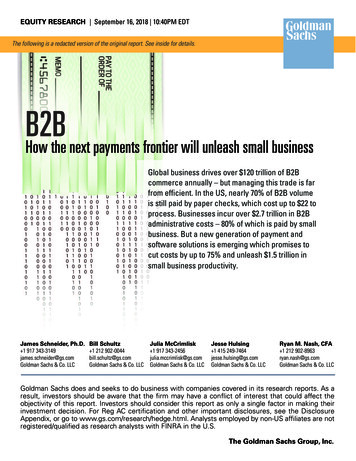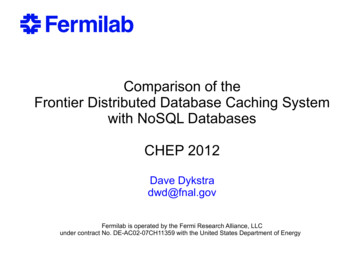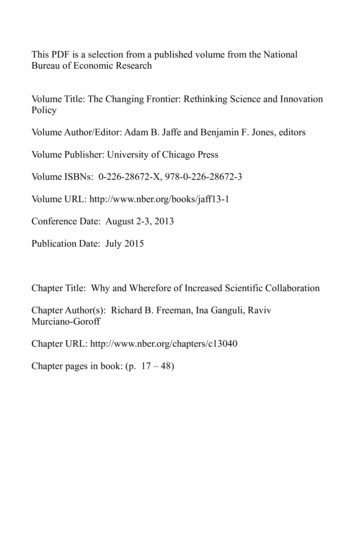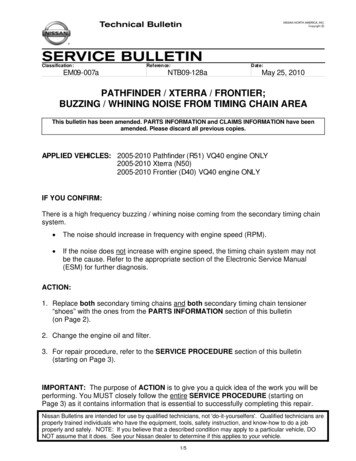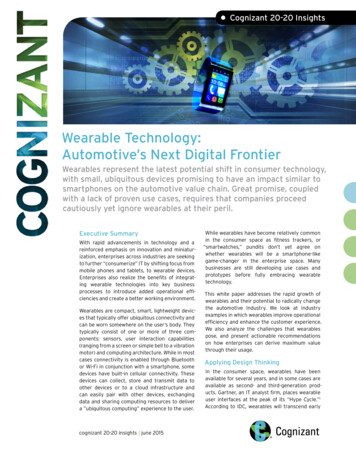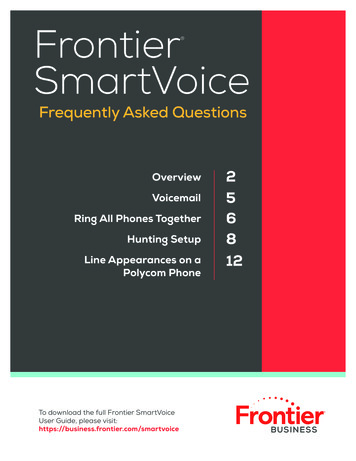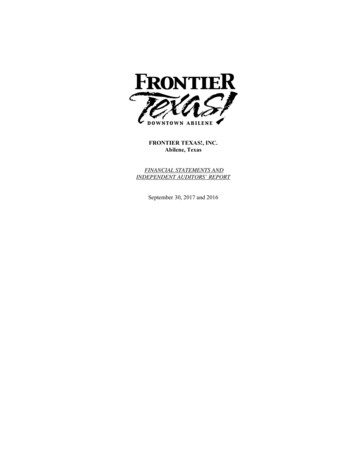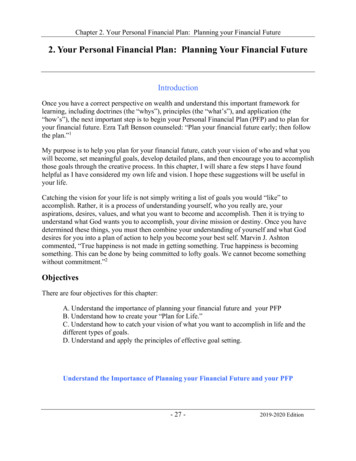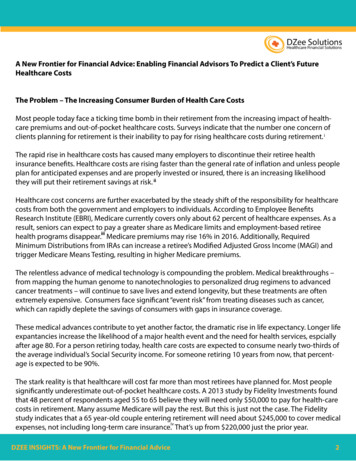
Transcription
A New Frontier for Financial Advice: Enabling Financial Advisors To Predict a Client’s FutureHealthcare CostsThe Problem – The Increasing Consumer Burden of Health Care CostsMost people today face a ticking time bomb in their retirement from the increasing impact of healthcare premiums and out-of-pocket healthcare costs. Surveys indicate that the number one concern ofclients planning for retirement is their inability to pay for rising healthcare costs during retirement. iThe rapid rise in healthcare costs has caused many employers to discontinue their retiree healthinsurance benefits. Healthcare costs are rising faster than the general rate of inflation and unless peopleplan for anticipated expenses and are properly invested or insured, there is an increasing likelihoodthey will put their retirement savings at risk. iiHealthcare cost concerns are further exacerbated by the steady shift of the responsibility for healthcarecosts from both the government and employers to individuals. According to Employee BenefitsResearch Institute (EBRI), Medicare currently covers only about 62 percent of healthcare expenses. As aresult, seniors can expect to pay a greater share as Medicare limits and employment-based retireeiiihealth programs disappear. Medicare premiums may rise 16% in 2016. Additionally, RequiredMinimum Distributions from IRAs can increase a retiree’s Modified Adjusted Gross Income (MAGI) andtrigger Medicare Means Testing, resulting in higher Medicare premiums.The relentless advance of medical technology is compounding the problem. Medical breakthroughs –from mapping the human genome to nanotechnologies to personalized drug regimens to advancedcancer treatments – will continue to save lives and extend longevity, but these treatments are oftenextremely expensive. Consumers face significant “event risk” from treating diseases such as cancer,which can rapidly deplete the savings of consumers with gaps in insurance coverage.These medical advances contribute to yet another factor, the dramatic rise in life expectancy. Longer lifeexpantancies increase the likelihood of a major health event and the need for health services, espciallyafter age 80. For a person retiring today, health care costs are expected to consume nearly two-thirds ofthe average individual’s Social Security income. For someone retiring 10 years from now, that percentage is expected to be 90%.The stark reality is that healthcare will cost far more than most retirees have planned for. Most peoplesignificantly underestimate out-of-pocket healthcare costs. A 2013 study by Fidelity Investments foundthat 48 percent of respondents aged 55 to 65 believe they will need only 50,000 to pay for health-carecosts in retirement. Many assume Medicare will pay the rest. But this is just not the case. The Fidelitystudy indicates that a 65 year-old couple entering retirement will need about 245,000 to cover medicalivexpenses, not including long-term care insurance. That’s up from 220,000 just the prior year.DZEE INSIGHTS: A New Frontier for Financial Advice2
DZee Solutions believes healthcare costs for consumers who live into their 90s and beyond are likely tobe substantially higher than the Fidelity numbers suggest.The Complication – Few Financial Advisors Feel Confident Discussing Healthcare Costs with TheirClientsIf financial advisors are to respond to these issues effectively, they will need to embrace change and stepout of traditional comfort zones, such as conversations about asset allocation. Indeed, the financialadvisor industry is facing new challenges from robo-advisors offering increasingly sophisticated andeasy-to-use web-based platforms to manage portfolios. Many predict these online systems will becomethe primary advice channel for future investors. Advisors will need to adapt their business models andembrace conversations that build stronger relationships with their clients, such as financial planning.However, financial planning itself will need to become more holsitic. A financial plan that doesn’t accurately account for these critical healthcare cost dynamics simply doesn’t have a good chance of success.Today, most financial advisors do not have the knowledge or tools to discuss healthcare costs withconfidence. A 2015 Allsup Medicare Advisor Seniors survey found that only 30% of RIA/planners arevconfident in their ability to estimate their client’s healthcare costs in retirement. Not surprisingly, onlyvi28% of seniors have discussed healthcare costs and Medicare with their financial advisors. Whilediscussing retirement healthcare costs with clients is new for many advisors, it’s imperative they soonlearn – or risk losing clients to an advisor who does. We believe these conversations will become a critical battleground for retaining clients and gathering assets.A critical first step for our industry is educating advisors about healthcare costs, but that isn’t sufficientby itself. Even if an advisor feels comfortable discussing the issues with clients, they still need help tomove from vague generalities about healthcare costs to client-specific estimates that are easy to generate. In the context of financial planning, the advisor can define specific cash flows (or goals) that moreaccurately represent likely healthcare liabilities in the future. Once an advisor defines these liabilities,he/she can work with the client to formulate a plan to fund them. This plan could include specific “buckets” of assets set aside to fund projectable healthcare costs, such as Medicare/insurance premiums andprojected out-of-pocket costs. The advisor can also do scenario planning to stress-test for events like“diagnosed with cancer.”Without such planning, retirees are more likely to face a future where higher-than-expected healthcarecosts steadily deplete their retirement savings or a significant health event brings financial ruin. We can’tsimply assume that retiree’s medical costs will be met by Medicare as they have in the past, especiallygiven solvency challenges Medicare will face.DZEE INSIGHTS: A New Frontier for Financial Advice3
Helping clients plan for these healthcare costs in retirement can represent a valuable planning and newrevenue opportunity for advisors. Healthcare planning, including insurance and annuities, can represent a new relationship opportunity for advisors – providing revenue while offering a much-neededservice to their clients.The Solution – DZee Real-time Healthcare Cost Prediction EngineDZee Solutions provides a solution that addresses these challenges and can help financial advisorsbuild stronger relationships with their clients. DZee’s patent-pending technology quickly guides advisors through the process of defining likely client-specific medical costs. The key enabling technology isour Healthcare Cost Prediction Engine, which can predict a client’s future healthcare costs on an interactive, real-time basis.Predicting an individual’s or family’s future healthcare costs is very difficult because it involves manyrandom variables and unknown health outcomes. Until now, healthcare cost predictions have beenbased on past actuarial data. This works well for modeling large groups of people in aggregate for thepurpose of setting insurance premiums, but it does a poor job of making accurate future healthcarecost predictions for a single individual, and doesn’t lend itself to real-time conversations, such as anadvisor illustrating “what if” scenarios interactively with a client.However, recent advances in Big Data, combined with cloud-based Machine Learning algorithms, nowenable accurate individualized healthcare cost predictions for both pre- and post-retirement planning.This technological breakthrough predicts future outcomes characterized by random variables andhealth outcomes. Just as Monte Carlo-based financial planning software makes stochastic variables outof asset class returns and inflation rates, so now does DZee Solutions enable an individual’s healthcarecosts to be a stochastic variable. The result is more informed and accurate financial planning.Simply put, Machine Learning algorithms note the relationships and patterns in massive datasets todetermine their type and quantity. The algorithms identify not just what’s happening with key knownvariables, but also new relationships that emerge from the data. The technology ranks the relativeimportance of all variables to predict future events and can distinguish what data should be includedand what shouldn’t. The algorithms are self-modifying and improving, producing individualized healthcare cost predictions with high accuracy and scalability.The information and financial data that feeds our engine is significant. The data includes the FederalGovernment’s CMS Medicare and Medicaid claim data, plus the All Payers Claim Data for all privateinsurance claims, plus relevant third-party data.These massive datasets about macro healthcare cost data and patterns represent only part of thepicture. What’s missing is the client-specific dataset, which is where the advisor comes in.It’s the interaction of these two datasets that makes the DZee solution so powerful.DZEE INSIGHTS: A New Frontier for Financial Advice4
Easy to UseThe DZee prediction engine is designed to be interactive. Our cloud-base engine requires a client toanswer only a handful of simple questions about their age, zip code, life expectancy and health status,and returns immediate results as either data or graphical content.To demonstrate how a client’s future healthcare costs can vary based on health and life expectancy,consider a married couple aged 50, who are in good health, live in Denver, CO, and expect to retire atage 65. Assuming a life expectancy of 80 years, the engine predicts the couple’s lifetime healthcarecosts, including premiums and out-of-pocket expenses will be 524,338. Assuming a life expectancy of90 years, the couple’s predicted healthcare costs increase to 935,012. Those extra ten years of life arevery expensive.The graph below summarizes the range of possible lifetime healthcare costs a couple might face,assuming a range of health grades and life expenctancies.The engine offers the flexibility to view projected healthcare expenses for both pre- and post-retirement. Cost projections can be delivered as a raw dataset that can be easily integrated via an API intofinancial planning software or other technology platforms. It also can return information using a varietyof graphs or detailed reports that show predicted annual lifetime healthcare costs.The DZee solution can also return an estimate of the money an investor will need to save to fund theirestimated future healthcare liabilities. These savings goals enable an advisor to frame the need for avariety of financial products, such as traditional investments, annuities, or insurance.DZEE INSIGHTS: A New Frontier for Financial Advice5
The Opportunity is NowHealthcare cost assumptions and predictions currently used in the financial services industry are unrealistic. Typically, financial advisors use a simple estimate of future healthcare costs. This often happensbecause the advisor either doesn’t want to scare the client or because they just don’t have the knowledge or information to discuss these costs properly. Such simple and overly optimisitic assumptions cancreate a ticking financial time bomb.Financial advisors who don't actively consider healthcare costs during retirement planning with clientsare missing out on a huge opportunity to differentiate themselves and tackle a subject that clientsincreasingly need and value.This is where DZee tools and education can help. Our prediction engine is easy for financial advisors touse and to understand, so they can easily help clients understand the implications of their age, healthand savings plans. Advisors armed with this information can have a more realistic discussion to plan fortheir client’s retirements, while differentiating their services and value relative to other advisors or roboplatforms. DZee also offers educational content that guides advisors about how to initiate client conversations about healthcare costs.For clients in their 30s and 40s entering their peak earning years, a conversation about future healthcarecosts can be just the thing to help them “get religion” about saving and investing for their future. Webelieve financial advisors should initiate this conversation with younger clients rather than waiting untilclients near retirement, when frankly, it may be too late to address inadequate savings.So why might a financial advisor engage clients in planning conversations about lifetime healthcarecosts? Primarily, because the advisor can greatly improve a client’s chances for funding their healthcareover a long retirement. But secondly, because an advisor can use this conversation to differentiate theirservices and gather new assets. Indeed, we estimate that if a financial advisor working in a full-servicefirm with a 45% payout rate was able to close just a single client each year with 1 milion of investableassets, the incremental revenue to the advisor would have a net present value of more than 87,000over a seven-year horizon. If that same full-service firm had 500 advisors close a single client each year,the incremental revenue to the broker-dealer would have a net present value of 106 million over aseven-year horizon. viiDZEE INSIGHTS: A New Frontier for Financial Advice6
A New Frontier for Financial Advice:Enabling Financial Advisors To Predict aClient’s Future Healthcare Costs
About DZeeDZee was founded in 2012 by a team of financial services, insurance, health care, and technologyexperts with a long history of creating and delivering high-end decision support systems. Their coreexperience involves building and implementing enterprise-wide Data Warehousing and decision-support systems for some of largest corporations and financial services organizations in the world. DZee’sprimary objective is to accurately predict future healthcare costs and enable financial advisors to betterplan for their clients’ healthcare expenses in retirement. DZee is the first to bring to market a new generation of Big Data machine learning capabilities to defuse the ticking time bomb facing the current andfuture generation of consumers.i, Genworth Cost of Care Surveyii, MetLife Employee Benefit Trends Studyiii, Employee Benefit Research Institute (EBRI)iv,Fidelity 2015 Couples Retirement Studyv, Allsup Medicare Advisors 2015 surveyvi, Allsup Medicare Advisors 2013 surveyvii, Assumes 1 client per year with 1 million of investable assets that earns 5% annually, pays 100 basis points on assets,with a payout rate of 45% to the advisor and 55% to the broker-dealer. Projections use a 7 year NPV discounted using a10% discount rate.DZEE INSIGHTS: A New Frontier for Financial Advice7
A 2015 Allsup Medicare Advisor Seniors survey found that only 30% of RIA/planners are con dent in their ability to estimate their client’s healthcare costs in retirement. Not surprisingly, only 28% of seniors have discussed healthcare costs an
